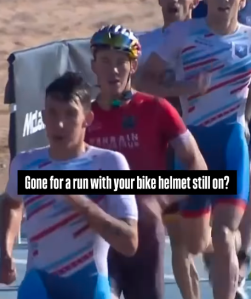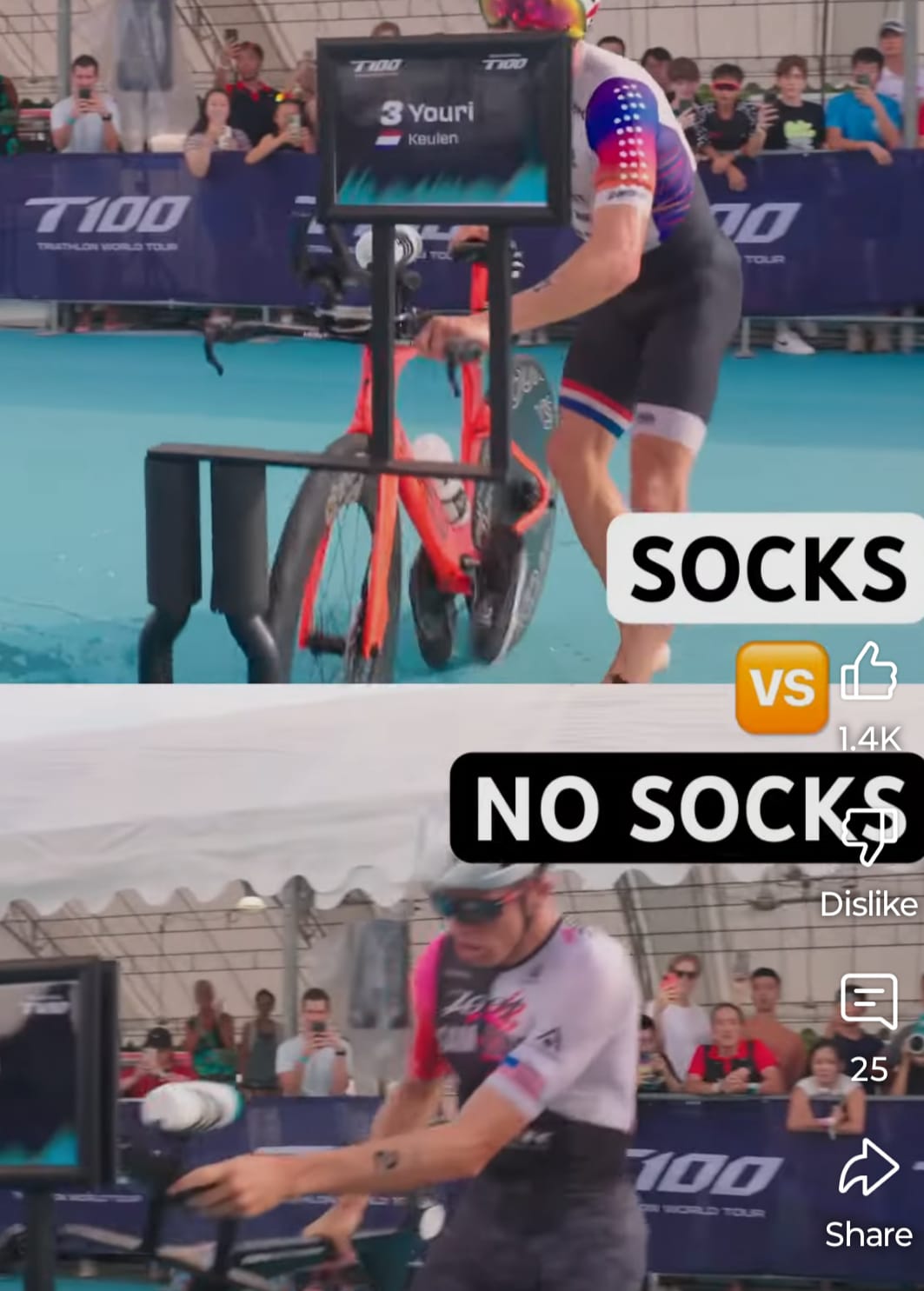Triathlon Transitions: 10 Hilarious Mistakes and How to Avoid Them
 Karen Parnell
July 09, 2025
Karen Parnell
July 09, 2025
The Fourth Discipline You Can’t Afford to Ignore
You’ve swum like a seal, you’ve biked like a beast, and you’ve run like the wind. But none of it matters if you face-plant in transition, lose your bike, or accidentally start your run with a wetsuit still flapping around your waist.
Welcome to the magical chaos known as transition. A place where dreams are made, races are lost, and the occasional malt loaf gets attached to your helmet.
Let’s unpack the most common transition mishaps – all of which definitely didn’t happen to me personally (spoiler: some of them did) – and how you can avoid starring in your own triathlon blooper reel.
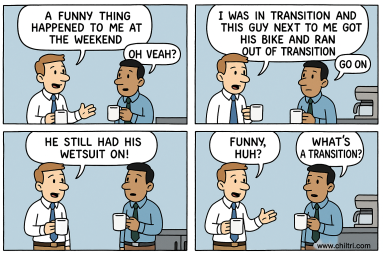
Get your FREE Swim Workouts for Triathletes E-book
What Is Transition Anyway?
In triathlon, transition is the bit between the sports where you stop doing one thing, start doing another, and try not to lose your dignity (or timing chip) in the process.
There are two official transitions in a triathlon:
- T1 (Swim to Bike):You emerge from the water like a triumphant sea creature, run barefoot into a giant field of bikes, strip off your wetsuit (ideally without falling over), throw on your helmet, grab your bike and make a mad dash to “Bike Out” and on to the mount line.
- T2 (Bike to Run):You dismount (ideally before the line), rack your bike, peel off your helmet, change shoes, and try to convince your legs that they now have to run instead of pedal. Bonus points if you can do this without accidentally carrying your bike helmet for the first 500 meters.
Think of transition as a high-stakes costume change, with time ticking and a referee watching. You can gain minutes with slick, efficient moves… or lose them by stepping into your running shoes with both socks stuck inside out.
And now, on to the greatest hits of transition misadventure…
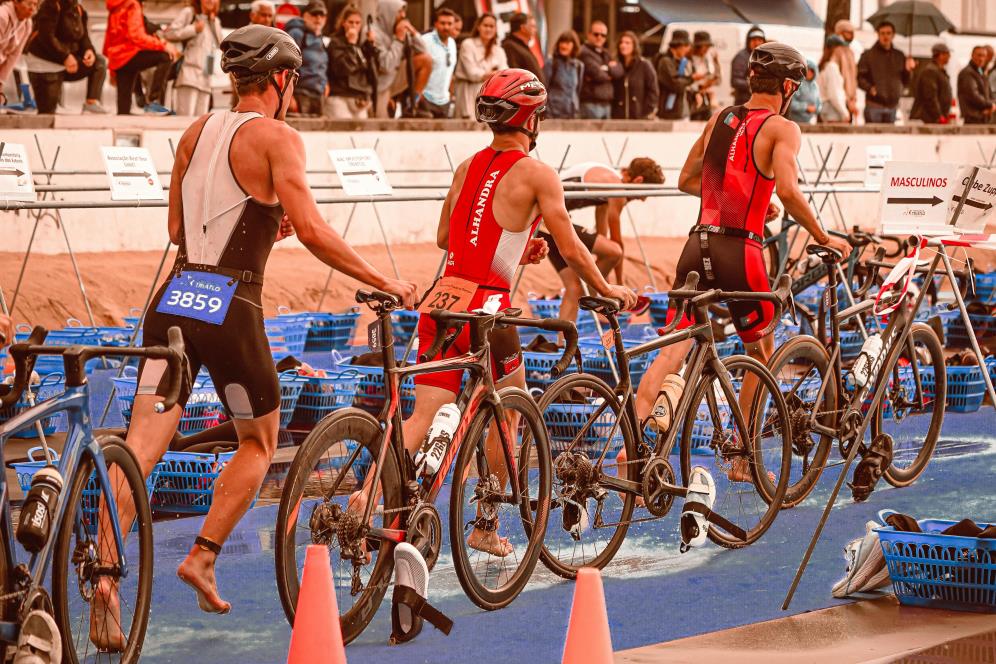
Photo by RUN 4 FFWPU
Get your FREE Open Water Swimming Sessions E-Book
1. The Classic Wetsuit Waddle
What Goes Wrong: You come out of the water pumped, run into T1, and… forget to take your wetsuit fully off and attempt to leave transition and ride your bike!
Personal Anecdote: I once made it onto the bike before I realized my legs were really hot and being cooked by neoprene. I looked like a torpedo with wheels.
Fix It Tip:
- Practice wetsuit removal until it’s second nature.
- Lube up arms and legs before the race to make removal easier.
- Clip your wetsuit zip cord to the Velcro strap so it’s easy to grab.
- Try the “stand-and-peel” technique: step on one leg of the wetsuit and pull the other out. It works.
- Chant “Goggles, hat, wetsuit OFF” as you exit the water.
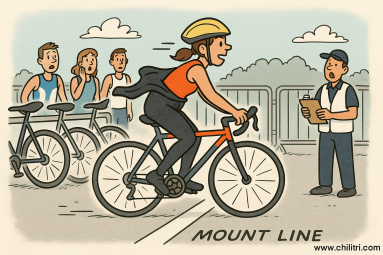
Get your FREE Open Water Swimming Sessions E-Book
2. The Helmet Horror
What Goes Wrong: You start the run… wearing your helmet.
Pro Anecdote: Even the pros can get it wrong – watch as Hayden Wilde does just that! He is really styling it out but maybe it is safety first? Watch the video below.
Haydon Wilde Running with his bike helmet on!
Get your FREE Guide to Running Speed and Technique
Bonus Anecdote: My partner who was a triathlon race official once noticed a squashed piece of malt loaf stuck to the helmet of a triathlete about to head off on his bike. He shouted out to the triathlete “Mate, is that malt loaf on your helmet?”. The triathlete reached up and found the squishy cake, removed it and sheepishly put it in his bike bento box to eat later on the ride. Note that malt loaf is not very aerodynamic!
Fix It Tip:
- Lay out your kit in the order you’ll use it.
- Place your helmet open and ready on your handlebars.
- Make helmet removal part of your dismount checklist: “Feet out, brake, unclip, UNHELMET.”
- Put your malt loaf in your bento box and not in your helmet!
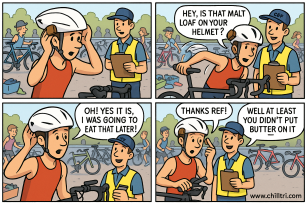
Maltloaf Meltdown!
Get your FREE Sprint Triathlon Training Plan
3. The Mount Line Madness
What Goes Wrong: You ride over the mount line. Ref whistles. Game over (or at least, time penalty).
Pro Anecdote: Alistair Brownlee got his dismount wrong coming into transition and rode over the dismount line. To try to avoid a penalty he ran with his bike back and in to transition running with his bike. Watch the video below – it happens at 1 minute 25 seconds.
Alistair Brownlee Dismount Line faux pas
Get your FREE Guide to Running Speed and Technique
Fix It Tip:
- Walk the transition area pre-race. Know exactly where the mount line is.
- Tape “Mount Here, Genius” to your handlebars if necessary.
- If you're doing a flying mount, practice with elastic bands securing your bike shoes to the pedals.
4. The Great T-Bone
What Goes Wrong: You get knocked off your bike as you enter T2 by someone dismounting on the wrong side.
Personal Anecdote: I was racing a sprint at Eton Dorney and had just completed a fast bike leg on closed roads and was thinking ahead to a fast, flat run. I was approaching the dismount line and saw a guy getting off his bike to the right, so I approached on the left side, but he changed his mind and dismounted to the left!
A big shoulder barge and I was tumbling down the rocks towards the water with my bike still attached. I was determined to finish and did not see the looks in transition. I got on to the run and noticed blood on my glasses and running down my leg. I finished but not as well as I wanted as the pain got worse as I ran. It was probably not the best idea to continue after a big crash.
Fix It Tip:
- Stay alert entering T2. Signal your intentions. Never assume anything!
- Practice dismounts, both sides if you're feeling fancy.
- If the dismount line is crowded, consider dismounting slightly further out and running over the transition line. This will allow you to manoeuvre easier around other athletes.
Heyden Wild dismount fail
Get your FREE 31 Structured Cycling Sessions and Training Plan
5. The Unclipping Fail
What Goes Wrong: You come flying into T2 and… forget to unclip. Cue slow topple.
Anecdote: A friend of mine did this in front of a crowd of kids. One of them asked if they needed stabilizers.
Fix It Tip:
- Unclip before you need to stop.
- If you are feeling bold slide your feet out and onto the top of your cycling shoes a few hundred meters from the transition line. This enables a quick dismount and for you to run barefoot into transition. Bonus: saves time putting on your running shoes!
- Practice slow-speed control and dismounts until your muscle memory takes over.
Flying Dismount fail!
Get your FREE 31 Structured Cycling Sessions and Training Plan
6. The Scavenger Hunt Setup
What Goes Wrong: You waste time in transition trying to find your gear.
Personal Anecdote: I once mistook someone else’s towel for mine and nearly ran off in their shoes. (They were brighter than mine. I swear.)
Fix It Tip:
- Use a brightly coloured towel or marker for your spot.
- Lay gear out logically: wetsuit > helmet > shoes > run kit.
- Keep goggles and swim cap well out of your way.
- Look at your transition space from different places in transition so you leanr the to get back to it - remember when you get ouf of the swim some bikes may have already gone so it will look different!
- Don't get angry if anyone moves your stuff around a bit - things get kicked and the Ref may have moved something if they consider it it impedding others.
How To Organise Your Triathlon Transition Set Up | Step-By-Step Guide by GTN
Get your FREE Triathlete Guide to Strength and Conditioning
7. The Nutrition Nightmare
What Goes Wrong: You forget to eat, drop your gel, or end up with food where it doesn’t belong.
Anecdote: I saw a triathlete tape a gel to their top tube too early on a hot day. It melted, exploded, and made their entire bike look like it sneezed banana goo.
Fix It Tip:
- Pre-open gels or bars slightly.
- Stick to a simple, rehearsed nutrition plan.
- Don’t tape anything to your bike unless it’s been tested. Repeatedly.
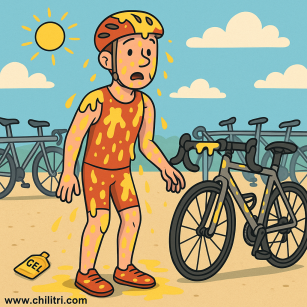
Get you FREE Athlete Recipe Books
8. The Gear Grinding Disaster
What Goes Wrong: You mount the bike, try to pedal away, and your bike refuses to budge. Why? Because you left it in your hardest gear like you're about to descend the Alpe d'Huez.
Personal Anecdote: I once tried to leave T1 in my big chainring and smallest cog. I moved approximately 6 inches before toppling sideways with all the grace of a brick. My chain made a noise that can only be described as 'mechanical despair.'
Fix It Tip:
- Before racking your bike, shift into an easy gear so you can spin up smoothly from a standstill.
- Practice a few mount-and-go efforts in your race gear setup so you know what feels manageable.
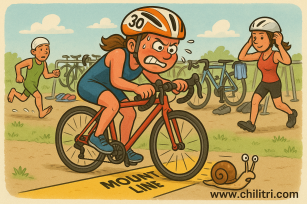
Get your FREE Swim Workouts for Triathletes E-book
9. The Sock Dilemma
What Goes Wrong: You try to shove socks onto wet, sandy feet while your fingers fumble like you've never dressed yourself before.
Personal Anecdote: I lost 40 seconds in my first triathlon trying to put on socks during a sprint tri. I was hopping on one foot, yanking at the heel like it owed me money, while three other athletes came and went like a pit crew at Silverstone.
Fix It Tip:
- For sprint or short-distance races, consider going sockless. Train without socks in advance to check for hot spots.
- For long-course races (70.3 or Ironman), socks are worth the time for blister prevention.
- Use lock laces on your shoes. They save time and remove the need for tying bows with adrenaline-shaky hands.
You can decide if you want to wear sock by watching the video below:
Socks versus No Socks
Get your FREE Sprint Triathlon Training Plan
10. The Wrong Way Roundabout
What Goes Wrong: You come out of the swim in a daze, grab your bike confidently, and run out of transition... in completely the wrong direction.
Anecdote: One time, my friend took a right instead of a left out of transition, did a full lap of the bike rack lanes, and ended up right back where they started—more confused than a GPS in a tunnel.
Fix It Tip:
- Arrive early and walk through the transition area before the race.
- Know exactly where the swim in, bike out, bike in, and run out points are relative to your rack.
- Count racks or landmark your row so you can find it when your brain is low on oxygen.
- Visualise your exact route through T1 and T2 a few times before the gun goes off.
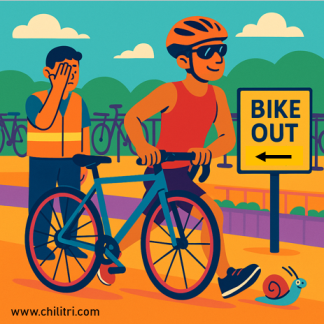
Get your FREE Guide to Running Speed and Technique
Conclusion: Learn to Laugh, but Also Learn to Prepare
Transitions are where the triathlon turns from a series of individual sports into a glorious, often absurd, three-part puzzle. The good news? Every mishap is a learning experience. (Or at least a great story.)
So, laugh at your mistakes, learn from mine, my friends and the pros, and most importantly – practice your transitions. Because nothing says “seasoned triathlete” like calmly removing your wetsuit, mounting and dismounting your bike well at the right place, and not doing the run in a helmet.
Karen Parnell is a Level 3 British Triathlon and IRONMAN Certified Coach, 8020 Endurance Certified Coach, WOWSA Level 3 open water swimming coach and NASM Personal Trainer and Sports Technology Writer.
Karen has recently completed a postgraduate MSc in Sports Performance Coaching at the University of Stirling.
Need a training plan? I have plans on TrainingPeaks and FinalSurge:
I also coach a very small number of athletes one to one for all triathlon and multi-sport distances, open water swimming events and running races, email me for details and availability. Karen.parnell@chilitri.com
Get your FREE Guide to Running Speed and Technique
Get your FREE Swim Workouts for Triathletes E-book
Get your FREE Open Water Swimming Sessions E-Book

Photo by Janik Presser on Unsplash
Get your FREE Swim Workouts for Triathletes E-book
Triathlon Transition FAQ: Your Questions Answered (Before You Forget Your Helmet Again)
What is a transition in triathlon?
Answer: A transition is the part of the race where you switch between disciplines—swim to bike (T1) and bike to run (T2). It’s basically a frantic costume change in front of hundreds of people, where time is still ticking, and you can’t remember where you left your shoes.
Why do transitions matter?
Answer: Because the clock doesn’t stop, and neither should you! Smooth transitions can save you precious minutes and prevent you from accidentally starting the run with your helmet on, or worse, still wearing your wetsuit. (Both have happened. Both are hilarious…)
How can I get faster at transitions?
Answer: Practice. Seriously. Set up mock transitions in your garden or empty car park. Time yourself. Rehearse wetsuit removal, helmet fastening, shoe changes. And walk the transition area before your race. Don’t just wing it unless you want to be the person sprinting back for their forgotten bike.
What should I lay out in T1 and T2?
Answer: Think assembly line:
- T1: Wetsuit off → helmet on (placed open on handlebars) → bike shoes on → go!
- T2: Helmet off → run shoes on → hat/gel if needed → run like you mean it.
And use a bright towel or marker to find your gear in the sea of spandex.
Do I need to use elastic bands for my bike shoes?
Answer: Not mandatory, but they’re a game-changer if you’re doing flying mounts. Just make sure you practice—you don’t want your shoe flinging off like a catapult at the mount line.
What are the biggest transition mistakes?
Answer: Glad you asked. Here’s a highlight reel:
- Riding past the mount line
- Falling over while unclipping
- Running with your helmet still on
- Starting the bike leg in your wetsuit
- Eating your nutrition… with your helmet
(Yes, I’ve done all of them. You’re welcome.)
Any tips for avoiding a gear scavenger hunt?
Answer:
- Use a bright towel or flag to mark your spot.
- Lay gear out in order of use.
- Practice transitions at home until it feels automatic.
- Don’t leave gels where they can melt into your helmet foam (ask me how I know).
How do I remember everything on race day?
Answer: Create a checklist. Walk the transition route. Talk yourself through it. Mentally rehearse. Then relax. If something goes wrong (and it might), laugh, fix it, and keep going. That’s the real triathlete spirit. Here's my free race day checklist.

